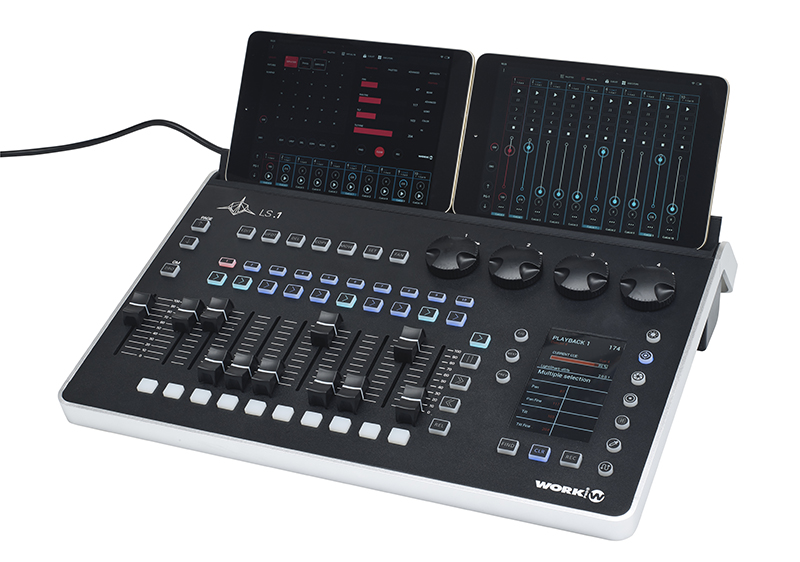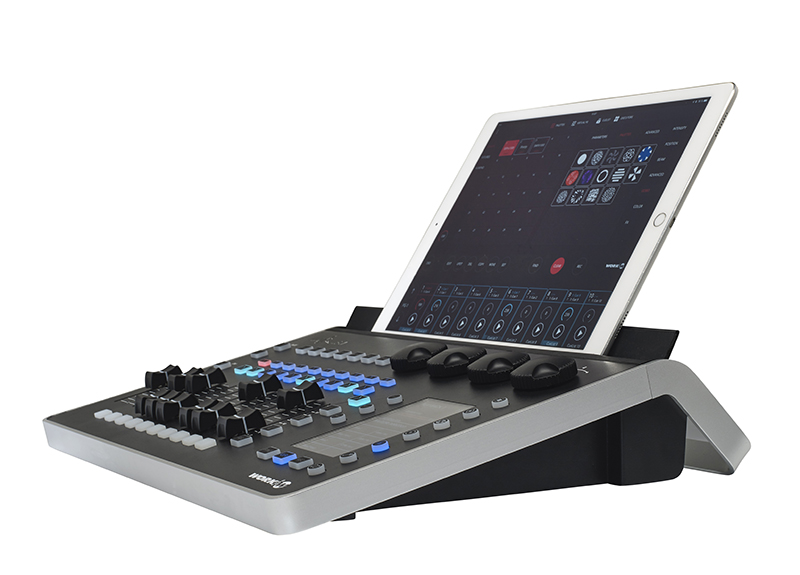
A choice of console is a personal one. A comforting familiarity lies in the execution of keystrokes, muscle memories made into clicks and key presses with nigh-thoughtless precision. The term itself is a misnomer, for of course memories are “stored” (that word itself being misleading, but this is PLSN, not the journal Neuroscience) and accessed in the brain, not the muscles. Our fingers rest on the curved edges of a number pad or go button; molded plastic controls as a moment of interface with our creative brains. For it is the brain that provides the most apt metaphor to start our discussion of lighting control; a console functions much as a brain does. It stores information, provides a way to access it, executes commands, and controls the devices to which it is attached. Today, we’re discussing the LightShark LS-1, an interesting control solution from Spain-based company WorkPro, with representation from Blizzard in America.
Web-Based OS
The appearance of the LS-1 suggests that it’s yet another PC-based “wing” solution that will be riddled by a pox of mandatory Windows updates and coworkers playing Farmville during down moments. This first glance, however, is deceptive. All of the software for the console runs within the hardware itself and control functions are accessed by attaching any device’s browser — whether you’re running that on a PC, tablet, or phone — to the device’s built-in wireless network, and pointing the browser to its internal address. This method stands in contrast to other “app”-based control solutions that run from the tablet itself, which seems likely to be a less stable control scheme. After startup, you’re presented with the LightShark software screen, which features a high-contrast color scheme. There’s a traditional three-button-icon “hamburger” preferences menu button at the top left for accessing system functions like patch, saving, recalling, and the scheduler. The main interface of the software is divided into tabs, with palettes, playback, cuelist, executors, and the programmer/output tab.
Patching is done in this main/preferences window, with lights selected from a list, and inputting the starting address, which features adjustable address offset. While there are fixture numbers, they are set internally in the console and are not user-changeable — the console expects you to access available fixtures by using the fixtures “grid” and groups in the programmer. For fixtures not in the library, users can make personality file requests from WorkPro, or use the console’s built-in fixture editor to make a new personality file from scratch. Alternatively, the fixture editor also lets one start from a copy of an existing fixture as a template. The company says that personality requests are generally turned around in a few days, but can be turned around faster in urgent situations. Notably missing are multi-part fixtures, which are not yet supported, but WorkPro says support is forthcoming.
Programming is done on the palettes tab, with a grid on the left-hand side for groups and fixtures, a numerical number pad for selecting fixtures and setting levels, and parameter control on the right-hand side. The parameters are broken down into intensity, position, beam, advanced (for things like control and macro channels), gobo, color, and effects. Controlling parameters is quite straightforward: you simply select the fixtures or groups that you wish to control, change their parameters, and record a cue, which appears in the cuelist pool and can be assigned to any playback that you like. There’s also a “Fine” switch in the parameter list for adjusting 16-bit parameters, while fanning attributes can be accessed with the “Fan” button, for quickly creating attractive lighting focus positions.
Color, Gobos and Effects
The console generates some default mixed color palettes, and gobo palettes with pictorial previews if the images exist in the library, but it’s up to the user to create any other palettes that they want to use. User palettes always apply only to the fixtures that are selected when making them, and user-made color palettes do not have a color preview like the built-in palettes, a feature that I would have liked to see. The LightShark includes an effects generator, with sine waves, sawtooth, squares, and circles. I found the effects generator is somewhat limited. For instance, you cannot reverse the effect direction in the editor; instead, you have to reverse your selection order. Despite the limitations, its inclusion is welcome, and further software updates could address some of the shortcomings.
Writing cues is straightforward, with a basic workflow of storing via the “Rec” button and pressing the playback that you want to store to. The LS-1 supports various fader modes, such as setting your fader to crossfade LTP parameters or controlling effects size or speed. There are 30 fader pages available, along with virtual faders and executors. One of my favorite functions is the “Executors” page, which is a grid where the user can place cuelists for instant access. Cuelists on the Executors page can also be set to momentary push, useful for busking or running shows on the fly. Each of the eight vertical columns can trigger just one cuelist at a time, so selecting another executor in the same column will deselect any others running in that column. Items in rows, on the other hand, can be stacked, with multiple items running at a time. The user can also drag their finger across rows to activate all of the cuelists in it at the same time. There’s also a grand master fader with dead black out (DBO) button, which can be set to either momentary or latching, per the user’s preference.

A Solid Feel
Physically, the console feels solid. Each fader has a selection, playback, and flash button, and an internal color screen on the right-hand side for programming, along with a selection of buttons for programming functions. Near the top, there are four rotary encoders for controlling attributes. In practice, I found both the physical encoders and the application easy to use and control for programming, but I had a slight preference for controlling things via the hardware as much as I could, which is probably due to my experience using primarily hardware consoles for much of my professional career and the fact that I found the angle more comfortable to use than a tablet docked in the built-in tablet holder that the LS-1 comes with. The DMX output of the console had no noticeable lag.
The LightShark LS-1 supports up to eight DMX universes straight out of the box, but only two are physically available on the desk — two connectors per universe, a three-pin and a five-pin XLR connector. I do not agree with the inclusion of three-pin XLR connectors; it seems to me that users will find the temptation to use the two outputs as a splitter irresistible, even though the manual explicitly says not to do this. The console also outputs Art-Net, sACN, DMX, OSC, UDP, and MIDI and connects to networks via a built-in EtherCON port. It also includes two USB ports for saving and recalling files and charging tablets, as well as a three-pin XLR for a desk lamp. Power in is via Neutrik PowerCON TRUE1, and the unit stands 10 cm (3.9 inches) tall, and is 43 cm (16.5 inches) wide, and 33 cm (12.9 inches) deep, and weighs 3.7 kg (8.1 lbs.), making it perfect to fit into carry-on luggage.
At a Glance
Compact and Full-Featured
The LightShark LS-1 is a surprisingly full-featured console for its size. With a full range of features including an effects generator, clever 64-cue executor grid, and support for eight universes (4,096 DMX parameters) out of the box, the LS-1 is an attractive option for houses of worship, clubs, and smaller touring bands.
LightShark LS-1
PROS: Effects generator, large number of universes, ease of programming, cost efficiency
CONS: Only two physical universe outputs, three-pin XLR
FEATURES
- Platform-agnostic OS w/built-in web server app
- 2x DMX outputs (XLR 3-pin & 5-pin)
- Ethernet port (TCP/IP, Art-Net, sACN)
- 2x USB ports
- Supports DMX-512, Art-Net, ACN, MIDI, UDP, OSC & HTTP
- Customizable fixture libraries
- RGB and CMY color picker
- Customizable executors window
- Supports OSC control software/MIDI console connections
- Manual crossfade for jumping quickly between cues
- Fanning function gives users quick access to fanning
- Extended cue memory allows for up to 1200 cues
- Built-in FX engine w/20+ customizable effects
- Submaster FX size and speed allows for accurate effect control
- Unlimited user palettes give users lot of possibilities
- Internal event scheduler for architectural applications
STATS
- Main Playback Faders: 10
- Virtual Playback Faders: 20
- DMX Universes/Channels: 8/4096
- Size: 16.9 x 12.9 x 3.9 inches
- Weight: 8.16 lbs.
- MSRP: $1,725
- Manufacturer: WorkPro
- Distributor: Blizzard
More Info: www.blizzardpro.com, www.workpro.es


